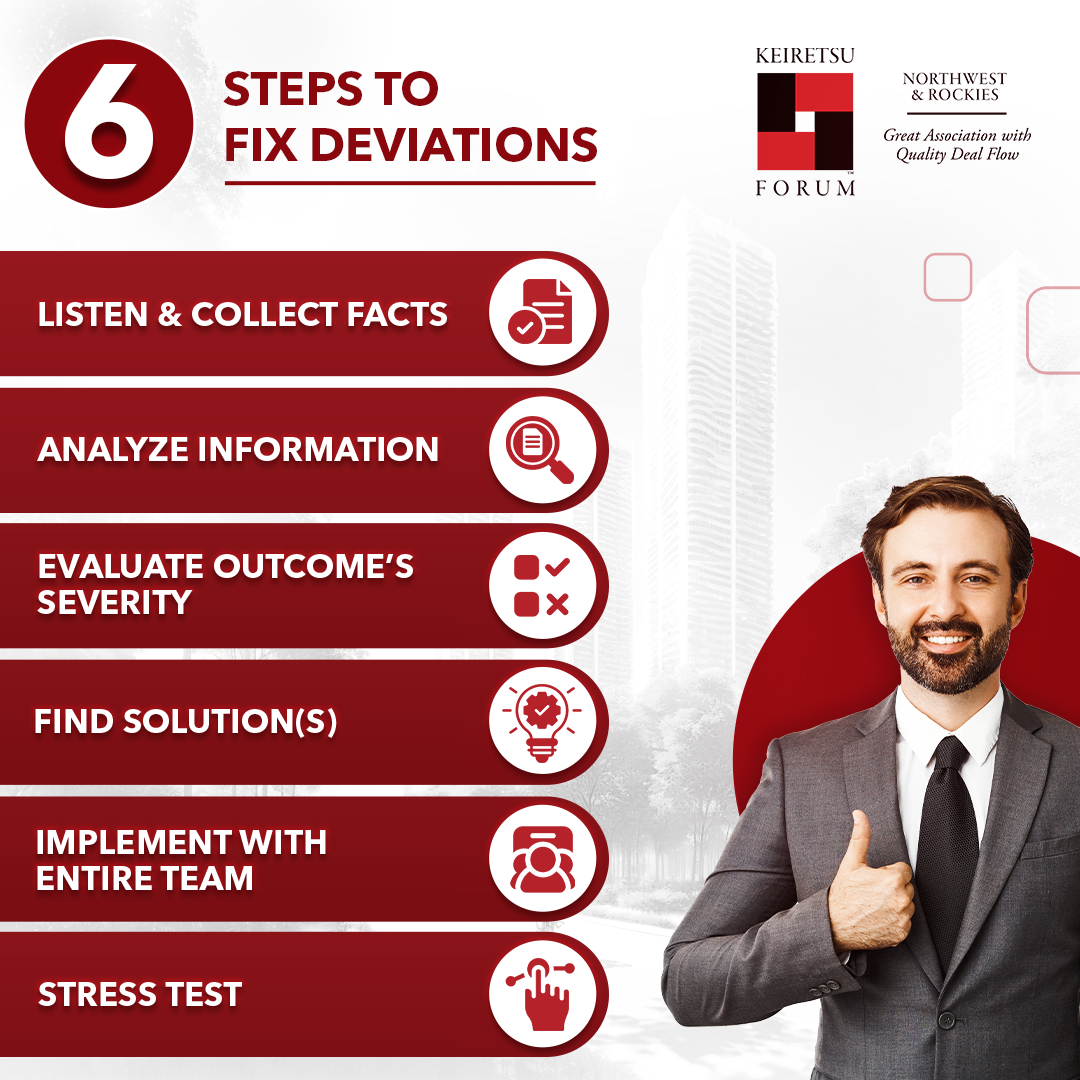
A business is never short of problems to address. Especially a younger firm finding its feet. It doesn't matter if the issue revolves around competition, financials or customer acquisition — when plans veer off track, panic can set in. However, with the right mindset and strategic approach, startups and investors can overcome the most daunting deviations. In his exclusive keynote, Keiretsu Forum member, investor and consultant Volker Hüther outlined his six-step process to resolve negative deviations. We will rely on his expertise to understand business crisis management, discover the three stages of 'deviation' grief, and learn first-hand from Volker's experience handling a floundering foundry business years ago. Ready? Here we go!
The Power of Reframing
While negative deviations trigger frustration, reframing them as positive inflection points can clear the path. Volker advises examining not just problems but even positive deviations. For instance, an unexpected revenue surge, though departing from projections, presents an opportunity to analyze the underlying drivers and recreate those 'happy incidents' strategically.
Likewise, negative deviations help identify and resolve deep-rooted issues impeding progress.
With this empowering perspective, let's explore Volker's six-step process for solving negative deviations. But hang on, before we do that, let's look at the first reactions to things going wrong. The responses at such a time can be called the 'Three Stages of Negative Deviation Grief'.
What are they?
Stage 1: Hiding
In the first stage, the team buries its head in the sand. Any signs of trouble are ignored or brushed aside. Call it "ignorance is bliss" or "If we don't acknowledge the problem, maybe it'll vanish." This approach is doomed to fail because hidden problems always come to light.
Stage 2: Arguing
As the problem persists and becomes hard to ignore, the team transitions into deflector mode. The underlying symptoms are rationalized away and argued against relentlessly. "But what about..." and "If only..." become commonplace excuses. Blame is assigned to external factors - suppliers, competitors, and the economy. A fierce "Not our fault!" mentality emerges.
Stage 3: Accepting
Finally, after journeying through the previous two stages of willful blindness, the awakening happens. There's an acceptance, an admittance of accountability for the deviation. The harsh light of reality is allowed to shine in, and the startup can begin to own and address the problem at last.
Now that we have dealt with the three stages of grief, let's dive straight in and look at how to solve a negative deviation! Crisis management at a business is hard, but here's a primer on what to do.
Step 1: Listen Intently and Encourage Open Feedback
The first step in Volker's approach is to listen – and listen deeply. This means creating an environment where every voice is heard, from the front-line staff to the senior leadership team. Suggestions for anonymous feedback channels can help facilitate an open exchange of ideas and concerns.
As Socrates advised, "Nature has given us two ears, two eyes, and but one tongue to the end that we should hear and see more than we speak." By listening intently without rushing to judgments or solutions, the team can lay the crucial foundation for well-informed corrective action.
Step 2: Analyze Objectively and Identify Patterns
With the raw feedback and facts collected, the next task is to analyze for common patterns and underlying themes. Such an analysis may not immediately reveal all the answers, but it will undoubtedly point people in the right direction.
Volker suggests engaging the team's creativity to simplify and communicate the analysis findings in a manner all stakeholders can comprehend. Strive to identify the connective threads that will gradually bring the full picture into focus.
Step 3: Evaluate the Severity and Urgency
Next, objectively evaluate the severity of the current deviation and how urgently it demands resolution. This pragmatic assessment will inform the pace and approach of corrective actions, ensuring resources are optimally allocated based on situational needs.
For example, a severe cash flow crisis would naturally require swifter interventions compared to a less acute deviation, say, in the workplace culture.
Step 4: Brainstorm Innovative and Permanent Solutions
With the groundwork laid, turn your collective efforts towards brainstorming innovative solutions that tackle the root cause – not just the symptoms. Avoid the pitfall of seeking temporary quick fixes that merely apply band-aids.
Throughout this ideation process, emphasize simplicity and clarity to foster widespread understanding and buy-in from all involved. Permanent solutions, even to complex issues, can be straightforward when approached with an open mind and a commitment to sustainable change.
Step 5: Implement Through United Team Effort
Implementation is where the rubber meets the road, and it's a team effort through and through. Ensure clear roles, timelines, milestones, and accountability mechanisms are established for each stage of the implementation strategy.
Depending on the deviation's severity and complexity, achievement of key milestones could potentially be celebrated and rewarded as morale-boosting "small wins." However, the primary focus must remain on the diligent execution of the overarching solution.
Step 6: Rigorously Stress Test and Fine-Tune
After implementing the corrective actions, follow rigorous stress testing and monitoring to validate whether the desired outcomes were achieved. Be prepared to fine-tune certain elements based on the results, consistently ensuring the underlying issues – not just the symptoms – are comprehensively resolved.
This process underscores the importance of thinking critically and objectively at every stage, adjusting course based on real-world data and insights.
To illustrate the real-world mechanics of this six-step process, Hüther shared a personal case study from his career as a management consultant.
Real-World Example: Turning Around an Ailing Foundry
The company, dubbed "Peterson" for confidentiality, was a foundry operating as part of a larger conglomerate's manufacturing supply chain for faucets. Financially, the situation was dire. Peterson's revenues were in the single-digit millions – undoubtedly disappointing for its corporate parent – and the company was incurring losses in the lower millions. Recognizing the foundry's inherent potential yet lacking expertise in the industry, Volker was tasked with the turnaround.
His first order of business was to understand the people and environment through comprehensive interviews and observations. The feedback was disheartening. Complaints abounded regarding stagnant wages, harsh working conditions, lack of structure, and customer grievances. There was an all-around unpleasant atmosphere that even the receptionist lamented. Volker realized the core issues were operational, cultural, and mindset-oriented.
One early catalyst for change was Volker's lighthearted wager with management over the heap of scrap materials languishing in makeshift "graveyards" around the facilities. By bringing this issue to light, inefficiencies fueling quality issues and unnecessary costs were noticed. Instead of recycling substandard scrap (which led to quality issues later) buying new raw materials paid dividends.
Volker also spoke to frontline workers one-on-one. By engaging an experienced machine operator and trusting his judgment, productivity gains were unlocked through minor workflow adjustments. He concluded "There are many, many more small but important wins that helped us to spiral into high profitability, satisfied customers and employees. So much that the GM eventually bought the company from the conglomerate and still delivers high quality innovative and profitable products."
In closing his presentation, Hüther left attendees with three key takeaways for mastering the art of course correction:
Key Takeaways for Business Crisis Management
1. Positive Attitude
Solving deviations requires a blend of optimism and realism. Let the enthusiasm for problem-solving radiate, but ensure it's balanced by pragmatism. This balanced mindset fosters an environment where people feel empowered to identify issues without fear of reprisal.
2. Cultural Environment
Creating an authentic culture anchored in continuous learning and growth is pivotal. A blame-oriented culture inhibits people from openly discussing underlying causes, stymieing progress.
Instead, normalize mistakes as learning opportunities, celebrate small wins and failures alike, and actively encourage personal and professional development.
3. Leverage Diverse Perspectives Through Critical Thinking
Most assume that subject matter experts and industry specialists hold the keys to problem-solving. However, Volker has witnessed the profound impact of incorporating fresh, outside perspectives through critical thinking. Purposefully engage diverse viewpoints that objectively question the "whys" and "hows" – these unique lenses can spark innovative disruptions to deeply entrenched challenges.
By internalizing and applying these three principles with the six-step framework, investors and startups can equip themselves with the mindset and methodology to manage a crisis at a business. Combine them with authentic leadership, and you possess the power to catalyze transformative change across organizations and industries.
The path to mastering the art of course correction is arduous but profoundly rewarding. By embracing the right mindset and strategy, you'll be equipped to transform deviations from roadblocks into launching pads for achieving lasting success through the art of continual growth and reinvention.
Source:
What to do when things go wrong - Volker Huther (Keiretsu Forum TV)


